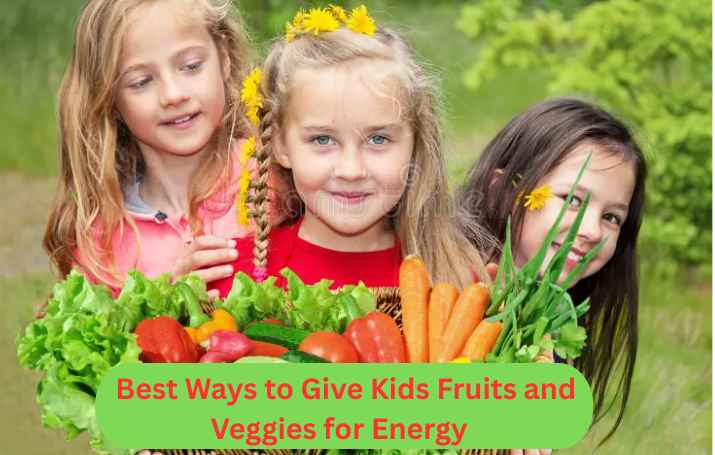
Best Ways to Give Kids Fruits and Veggies for Energy

Introduction
Getting kids to eat enough fruits and veggies is important for their health, growth, and daily energy. These foods give you important nutrients, like minerals, vitamins, fibre, and antioxidants, that keep your brain healthy, your immune system strong, and your body busy. But as many parents know, it can be challenging to get kids to eat their veggies or try new fruits.
You don’t have to bargain to get your child to eat fruits and veggies. There are simple and creative ways to make them a normal part of their meals and snacks. This blog has useful tips that make it easy for kids and adults to eat well. Not only should kids eat many vegetables, but they should also learn good habits that will last a lifetime.
Why Fruits and Vegetables Matter for Kids Energy?
Children are constantly growing and burning energy throughout the day—whether at school, during play, or in sports. Nutrients from fruits and vegetables help support:
- Energy metabolism (B vitamins from leafy greens and bananas)
- Immune function (Vitamin C from citrus fruits and berries)
- Muscle repair (Antioxidants from colourful veggies)
- Brain function (Iron from spinach, antioxidants from blueberries)
- Hydration and digestion (High water and fibre content)
Unlike processed snacks that provide short bursts of energy followed by crashes, fruits and vegetables help sustain energy steadily over time.
1. Start Early and Be Consistent
People start to develop their taste preferences when they are very young. Kids are more likely to eat and appreciate fruits and vegetables later if they are exposed to a wide range of them at a young age. There is always an opportunity to make a difference, even if your child didn’t start early. Give vegetables often in modest amounts, but don’t force or pressure them.
Tip: A child may not like a new food until they have tried it 10 to 15 times. Keep offering, but don’t make a big deal out of refusals.
2. Make Fruits and Vegetables Easy to Grab
For the most part, kids eat whatever is easy to get to. They are more likely to choose something healthy if you keep washed and chopped fruits and veggies in the fridge or on the counter.
Ideas:
- Keep a bowl of fresh bananas, apples, or grapes within easy reach.
- Store carrot sticks, cucumber slices, or cherry tomatoes in see-through containers at eye level in the fridge.
- Pre-pack fruit in reusable snack bags for school or travel.
3. Blend Them into Smoothies
Smoothies are a great way to combine several fruits (and even hidden vegetables) into a single, tasty drink. Most kids won’t notice a handful of spinach or a few pieces of avocado blended with banana, mango, or berries.
Basic Energy-Boosting Smoothie Recipe:
- 1 banana
- 1/2 cup frozen berries
- 1/2 cup spinach
- 1/2 cup plain yogurt or milk
- 1 tsp honey (optional)
Smoothies are best served fresh but can also be prepped in freezer-safe pouches for quick morning options.
4. Add Fruits and Vegetables to Favourite Dishes
You don’t always have to serve vegetables separately. Incorporate them into dishes your child already likes.
Examples:
- Add grated carrots or zucchini into pasta sauces or meatballs.
- Mix chopped spinach into omelettes or scrambled eggs.
- Add mushrooms, onions, and peppers into quesadillas or sandwiches.
- Top pizza with extra veggies like corn, olives, or tomatoes.
This method doesn’t replace teaching kids to eat veggies on their own, but it helps increase intake without resistance.
5. Offer Dips and Pairings
Kids love to dip. Providing a healthy dip alongside fruits and vegetables can make them more appealing.
Good combos:
- Apple slices with peanut or almond butter
- Carrot sticks with hummus
- Cucumber slices with yogurt dip
- Celery with cream cheese
These combinations not only enhance taste but also provide additional energy from healthy fats and proteins.
6. Use Fun Shapes and Presentations
Visual appeal can make a big difference, especially with younger children. Use cookie cutters to create fun shapes from watermelon, melon, or cucumbers. Arrange fruits in rainbow patterns or make a “vegetable face” on a sandwich.
Other ideas:
- Make fruit kebabs on skewers.
- Create vegetable “boats” with cucumber slices filled with cheese or hummus.
- Build a smoothie bowl with fruit “smiles” and granola “eyes.”
7. Let Kids Help with Cooking and Shopping
When kids are involved in food preparation or grocery shopping, they feel more ownership and curiosity about what they’re eating.
Suggestions:
- Let your child choose one new fruit or vegetable each week.
- Involve them in simple cooking tasks like washing produce, tearing lettuce, or stirring smoothies.
- Talk about colours, textures, and Flavours as you cook together.
The more familiar they are with ingredients, the more likely they are to try them.
8. Set a Good Example
Children are heavily influenced by the eating habits of adults around them. If they see you regularly enjoying fruits and vegetables, they’re more likely to do the same.
Try to:
- Eat meals together when possible.
- Include fruits or vegetables in your snacks.
- Avoid negative language around food (e.g., “You won’t like that”).
Creating a positive and balanced food environment at home has a lasting impact.
Final Thoughts
As time goes on, kids will learn to eat fruits and veggies. Every child is different, and it takes time. Some children may need more help with various foods, while others might enjoy fruits but avoid vegetables. Don’t make it a stressful job; just keep trying.
Give your child tiny amounts of food, vary things up, and allow them to try different colours and flavours. Let them help wash, peel, or put food on the plate. These little things can change how they think about healthy food a lot.
Most kids will start to like and even adore fruits and veggies if you keep trying and stay positive. Making habits that last is the most important thing.
Our PrimeNuts Products



